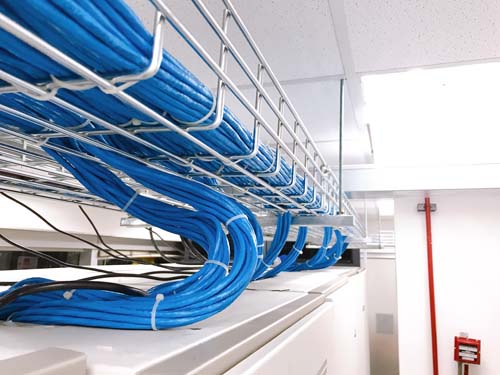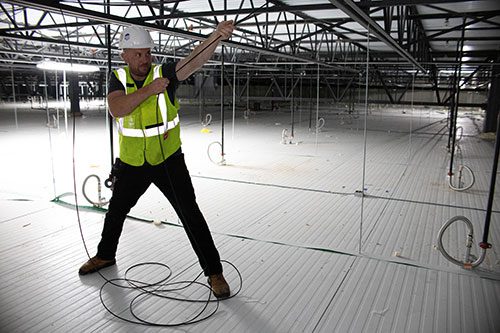"*" indicates required fields
It’s important to make sure your business has reliable technology that you can count on for years to come. Whether you realize it or not, having advanced technology services allows your South Jersey, Bucks County, or Montgomery County company to grow.
That’s why when businesses are looking for Cat6 installers, they turn to the technicians at Network Drops. With a great knowledge and background of Cat6 wiring, Cat6A wiring, Cat6 cabling, and Cat6A cabling, we only install systems and products that are of the highest quality and also meet our client’s expectations.
We have a strong client base of business owners throughout Monmouth County, Mercer County, Middlesex County, Montgomery County, Bucks County, and other parts of Pennsylvania and New Jersey. Our team of technicians works to make sure they fulfill any requests you may have about your Cat6 and Cat6A wiring and cabling.
It is important to make sure any type of Cat6 cabling installation is performed correctly. That’s why when our Cat6 installers come to your location, they take the time that is necessary to make sure all Cat6 wiring and Cat6A wiring is terminated, supported, routed, and connected properly to the IT room of your business or office.



For optimal network performance and high-speed data transmission, a meticulous approach to network cabling installation is imperative. Utilizing high-quality materials such as shielded cable, RJ45 connectors, and patch panels ensures reliable connectivity. Upgrading from traditional Cat5 cables to higher-grade cables like Cat6, with frequencies reaching up to 500 MHz, future-proofs your network by accommodating increased data demands.
Incorporating fiber optic cables alongside copper cabling enhances network speed and offers flexibility, especially when considering Power over Ethernet (PoE) capabilities for efficient power distribution. Employing cable trays and effective cable management techniques across 55 meters of infrastructure guarantees a well-organized setup conducive to optimal network performance.
A robust network setup requires meticulous planning, particularly in the selection and installation of the appropriate type of cable. High-quality shielded cables, rated at 250 MHz or above, combined with proficiently installed patch panels and RJ45 connectors, bolster network efficiency. Transitioning to higher-grade cables like Cat6, offering superior frequencies up to 500 MHz, fortifies the network against data congestion, ensuring it remains future-proof.
The integration of fiber optic cables alongside traditional copper cabling enhances network capabilities, especially when considering Power over Ethernet (PoE) for diverse power and data needs. Effective cable management, encompassing cable trays and meticulous organization, optimizes network performance across a span of 55 meters, fostering an environment conducive to high-speed data transfer and reliable connectivity.
CAT6 and CAT6A cabling are particularly well-suited for businesses that heavily rely on high-speed, reliable network connections. Some industries and businesses that benefit significantly from CAT6 and CAT6A cabling include:
Ultimately, any business that prioritizes high-speed, reliable network connectivity and deals with large data volumes or multimedia content can greatly benefit from the installation of CAT6 or CAT6A cabling.
Bucks County
Philadelphia County
Montgomery County
Delaware County
Berks County
Middlesex County
Mercer County
Burlington County
Monmouth County
Gloucester County
Bergen County
Camden County
Atlantic County
Somerset County
Cumberland County
A: CAT6 cable is primarily used for Ethernet networking. It supports higher data transfer speeds compared to its predecessors, making it suitable for applications that demand faster network connections. It’s commonly used in commercial setups for transmitting data, internet, and multimedia applications.
A: CAT6 cables have specific limitations when it comes to their maximum length for optimal performance. The standard maximum length is 328 feet (100 meters) for reliable data transmission. Additionally, the cable needs to be installed properly to avoid signal interference or degradation due to bends, crimps, or electromagnetic interference.
A: While CAT6 cables are suitable for indoor use, they aren’t designed to withstand outdoor elements without additional protection. If you intend to run CAT6 cables outdoors, it’s recommended to use outdoor-rated cables specifically designed to endure environmental factors like moisture, UV exposure, and temperature changes.
A: CAT6 cable and CAT6A cable differ mainly in their performance capabilities. CAT6A (Category 6A) offers higher bandwidth and faster data transmission speeds compared to CAT6. CAT6A supports 10 Gigabit Ethernet at longer distances and has stricter specifications for reducing crosstalk and interference.
A: CAT6 ethernet cabling is designed to carry signals up to a maximum distance of 328 feet (100 meters) before experiencing significant signal degradation. To ensure optimal performance, it’s crucial to adhere to this maximum length and consider using signal boosters or repeaters for longer distances.